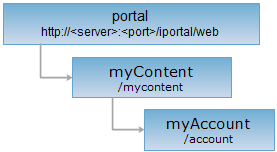<mycontent_uri>/account[.<format>]
The account information for the current user, that is, my account.
Supported Methods:
Supported output formats: rjson, json, html, xml.

Implement the HTTP request on the following URI, where supermapiserver is the server name, with rjson being the output format.
http://supermapiportal:8090/iportal/web/mycontent/account.rjson
Get the account information for the current user.
The structure of the response resource representation after implementing the GET request on the myAccount resource will be as follows:
| Field | Type | Description |
| description | String | User description info. |
| String | The email address of user. | |
| name | String | Username. |
| nickname | String | User nickname. |
| ownRoles | String[] | The role associated with the user, not including the role of the group where the user is in. |
| password | String | The user password. |
| roles | String[] | The role associated with the user. |
| passwordQuestion | IportalPasswordQuestion | The security question and answer that is used to reset the password. |
| userGroups | String[] | The user group. |
The returned rjson format representation after implementing the GET request on the user resource http://localhost:8090/iportal/web/mycontent/account.rjson is as follows:
{
"description": null,
"email": null,
"name": "admin",
"nickname": "admin",
"ownRoles": null,
"password": null,
"passwordQuestion": {
"pwdAnswer": null,
"pwdQuestion": "school"
},
"roles": [
"ADMIN",
"SYSTEM"
],
"userGroups": null
}
Asks for the response identical to the one that would correspond to a GET request, but without the response body. This is useful for retrieving meta-information written in response headers, without having to transport the entire content. The meta-information includes the media-type, content-encoding, transfer-encoding, content-length, etc.
HEAD request can be used to check if the myAccount resource exists, or if the myAccount resource can be accessed by clients. It can also determine if the myAccount resource supports an output format <format> if performed on a URI with .<format> included.